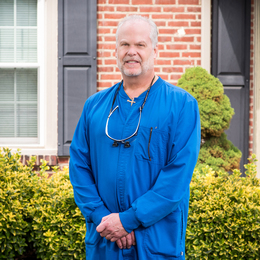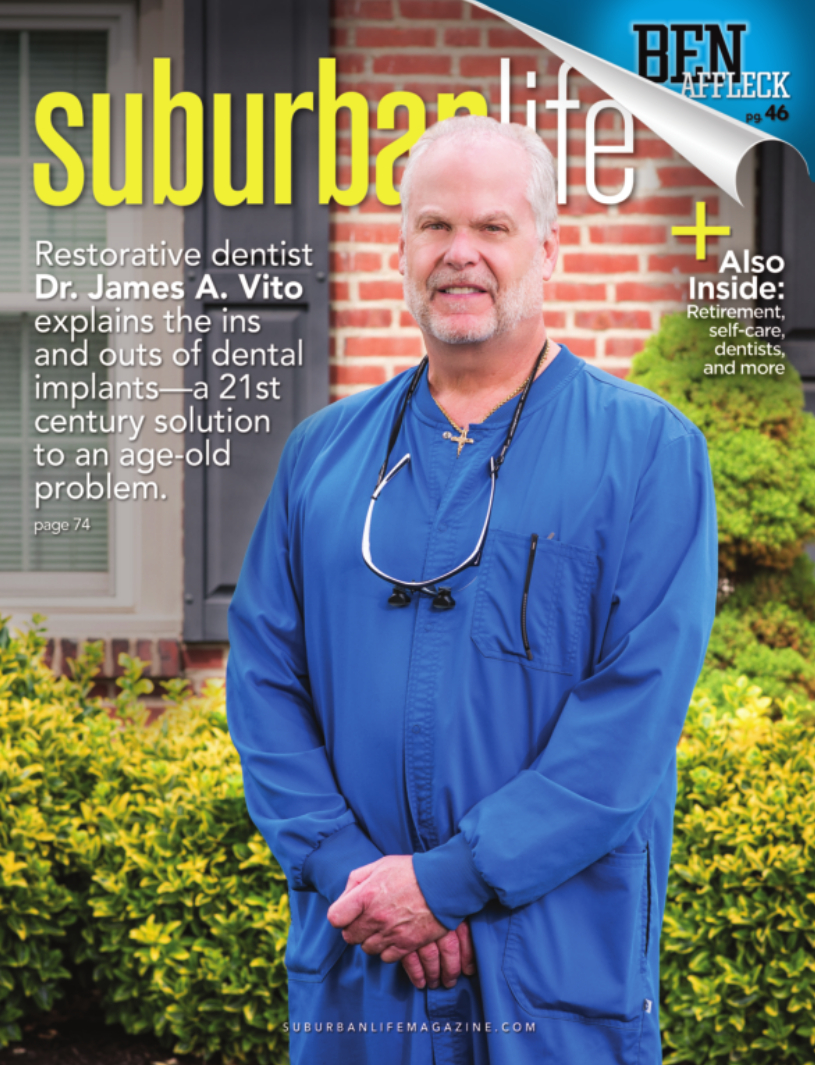
21st Century Solution to an Age-old Problem
Restorative dentist Dr. James A. Vito explains the ins and outs of dental implants.
Ever since man has been able to walk upright, he has been plagued by tooth loss. Everything from seashells, gold, wood, and ivory spikes—and yes, even other people’s teeth—have been used to recreate a full smile.
Many adults will face the problem of tooth loss in their lifetime. At least 120 million Americans are missing at least one tooth, and as many as 36 million are missing all of their teeth, according to the American College of Prosthodontists. The problem is expected to worsen in the next 15 years, affecting as many as 200 million Americans. Fortunately, dental implants are available to permanently replace a missing single tooth, or all your teeth, and restore your smile.
Dental implants are the closest thing you can get to healthy, natural teeth. They allow you to live the way you want to—confidently eating, smiling, talking, kissing, and enjoying everyday activities without worrying about your teeth. Dentists mostly recommend dental implants for replacing lost teeth because, in functionality and characteristics, the implanted tooth almost behaves like a natural tooth.
Because dental implants function just like natural teeth, you still have to properly care for them, just like you do with your teeth. That’s why it’s important to visit your dental implant dentist periodically for follow-up checkups, just as you do your regular dentist. Dental implants that are properly cared for will last many decades.
Of the more than 5 million implants placed each year in the United States, approximately 95 percent succeed. But some people experience dental implant failure. It’s estimated that about 5 to 10 percent of dental implants fail, either shortly after the procedure or months or years later.
Early failure refers to the failure of a dental implant within several weeks to months, and results from issues such as bone necrosis, bacterial infection, surgical trauma, inadequate initial stability, and early occlusal loading. Late failure occurs after restorations are placed and your teeth are in function for a period of time. It stems from excessive loading that results in infection of the bone and gum tissue.
Factors that influence the success or failure of dental implants include the following:
1. Infection: It is important prior to implant placement that the bone and gum health of the implant area be as healthy as possible to facilitate the healing process. Well-trained implant dentists will prescribe an antimicrobial rinse and antibiotics to mitigate risk of infection after your procedure.
2. Quality of supporting bone: The quality of bone can affect the initial stability and length of time it takes the implant to integrate with the bone. Generally, it takes four to six months, or longer, for an implant to integrate into soft bone. There is increased risk for the possibility of micro-movement in soft bone, and this can prevent the implant from integrating, leading to implant failure. It is important that your dental implant surgeon evaluate the height, width, and density of your bone prior to dental implant placement.
3. Gum tissue: As important as bone is the width of keratinized tissue surrounding an implant. This tissue protects the dental implants. It needs to be a minimum width of 5 to 7 mm to provide protection for the bone and longevity of the dental implant.
4. Health factors: Smoking and diabetes can influence the blood supply to the supporting bone and gum tissue, which is crucial for healing of dental implants. Smoking can reduce the blood supply to gums and supporting bone. This slows down the healing process and can increase the risk of implant failure. Uncontrolled diabetes leads to poor healing and increased susceptibility to infection, which can lead to implant failure.
5. Oral hygiene: The implanted tooth/teeth can be cleaned like other natural teeth. The area under the “implant restoration” should be carefully cleaned to remove food debris and bacteria. Accumulation of food particles and bacteria around and under the implant restoration can increase the risk of peri-implant infection.
6. Other factors: Host-related factors include the age and gender of the patient, smoking habits, systemic disease, and oral hygiene. Implant placement site-related factors include arch position and the quality and quantity of bone. Surgery-related factors include initial stability, angulations, and direction of implant, as well as the skillfulness of the clinician. Implant fixture-related factors include surface roughness, length and diameter of dental implant, and the macrostructure and microstructure of an implant fixture. Implant prosthesis-related factors include the type of prosthesis, retention method, and occlusal scheme.
Ask the Doctor
People tend to ask a lot of questions during my dental implant consultations. Following are some of the most common ones.
* “How long will a dental implant last?” As many as 95 percent of dental implants have been reported as successful over 10 years. It has become the treatment of choice in 2021.
* “Who is not suitable for dental implants?” People who take certain medications, such as steroids or drugs that suppress the immune system, may not be suitable candidates. Certain habits, such as people who severely grind or clench their teeth, may put too much pressure on the implants. These habits may cause long-term damage, and must be evaluated carefully by their dental surgeon prior to any dental implant surgery.
* “What happens if you don’t have enough bone for dental implants?” Having adequate bone and soft tissue is important for long-term dental implant success. If you don’t have enough bone or gum tissue, bone can be rebuilt and gum tissue can be added through procedures that must be performed prior to the placement of implants.
* “What happens when a tooth is removed and not replaced?” When a gap is left by a missing tooth, the surrounding teeth have a tendency to shift because that tooth is no longer helping to keep everything in line. Ultimately, teeth may become crooked or new gaps may appear between teeth. Also, a lost tooth may result in bone loss at the site, which can be prevented by getting a dental implant as soon as possible.
* “Who is best qualified to do dental implant surgery and reconstruction?” Choosing a knowledgeable, well-trained implant dentist will help minimize complications and ensure skillful handling of any complications, should they arise. Look at your implant dentists’ credentials. Oral surgeons and periodontists are trained in the surgical placement of dental implants. Prosthodontists are dentists with special advanced training in dealing with complicated restorative issues and dental implant restorations. Board certifications are also important, especially those that are specific to dental implants, such as the American Board of Oral Implantology/Implant Dentistry and the International Congress of Oral Implantologists.
For more information on what dental implants can do for you, or if you are experiencing issues with your existing dental implants, I welcome you to contact me.
About Dr. Vito
Dr. James Vito has been doing adult restorative dentistry, as well as dental implant surgery and dental implant reconstruction, since 1987. He received his dental training and his specialty training in Periodontics and Periodontal Prosthesis/Fixed Prosthodontics from the University of Pennsylvania School of Dental Medicine. He received additional dental implant surgery and dental implant restoration training at the Misch International Implant Institute under the tutelage of Dr. Carl Misch, one of the preeminent dental implant pioneers and specialists. Dr. Vito is board certified by both the American Board of Oral Implantology/Implant Dentistry and the International Congress of Oral Implantologists.
Dr. James A. Vito, D.M.D.
523 East Lancaster Ave
Wayne, PA 19087
610-971-2590
Photograph by Jeff Anderson
Published (and copyrighted) in Suburban Life magazine, October 2021.



